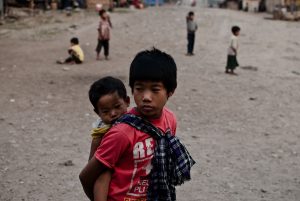While writing about the heartening campaign of civil disobedience that has emerged since the February 1 coup in Myanmar, it was hard not to note the lack of a similar reactions during past military outrages: in particular, the army’s merciless assault on the Rohingya Muslims of Rakhine State in 2017.
This is intended as an observation rather than as a judgment. It is undoubtedly true that many ethnic Burmans harbor prejudice against the Rohingya or view them (much as the government does) as illegal immigrants from Bangladesh. It is also probably natural for people to react to immediate local outrages more strongly than to less tangible, far-off ones.
But the reason I’m raising this is that it struck me as a good illustration of a divide that runs through the heart of Myanmar’s politics. In many ways, the events culminating in this week’s coup are an outgrowth of a long-running struggle for and within the ethnic Burman-dominated central state – a struggle that remains separate from, if sometimes connected to, the struggles for autonomy that have simmered along Myanmar’s periphery since independence in 1948.
In her 2005 book, “Making Enemies: War and State Building in Burma,” the scholar Mary Callahan argued that Myanmar’s long years of military dictatorship could be explained as an attempted solution to “centuries-old structural problems of state building” in the regions beyond central Myanmar. These were regions that had rarely, if ever, been under the control of the precolonial Burman kingdoms, and retained a great deal of practical autonomy under the British.
For Callahan, these military-led state-building efforts, and the efforts of ethnic minority peoples to resist them, were largely “remote from the Rangoon-centered struggles between the regime and the opposition led by Aung San Suu Kyi.” She then went on to note, presciently, that the challenge of state-building on the periphery would pose daunting challenges not only for the military junta “but also for any future regime, democratic or otherwise.”
Indeed, over the past 10 years of civilian government, the approach of the NLD and military to these regions has been different in degree rather than in kind. Both have committed themselves to an extractive form of capitalism that has led to land grabs and displacement in minority regions; both have also been high-handed and insensitive, if to differing degrees of intensity, in their dealings with ethnic armed organizations and minority communities.
As an example of the latter, one could point to the various protests against the government’s erection of statues of General Aung San – Aung San Suu Kyi’s father – in ethnic minority regions. Revered by many ethnic Burmans as an independence hero, he is viewed with some ambivalence in minority communities – unsurprisingly, given that he helped establish the Myanmar military with which some have been at war for years. After the 2015 election, the NLD also erred in appointing its own chief ministers for the ethnic states, rather than appointing local representatives, and seemed set to do the same after last November’s election.
As Ko Leik Pya wrote in an interesting structural analysis of the coup this week, “the institutional oppositions of the power elite are conducted on a platform built on a broad consensus (or doxa) of a political economy based on extractive capitalism and a centralized Bamar-State.”
While many NLD politicians and ethnic Burmans have stood up for the rights of ethnic minority peoples, the mistrust is such that people in these regions could be forgiven for viewing the NLD and military as different shades of the same color – as representatives of a state that seeks to subordinate them to an ethnic Burman-dominated central authority.
In the aftermath of the coup, Saw Kwe Htoo Win, vice chairperson of the Karen National Union, said that the country’s minority communities had gained little from 10 years of “so-called democracy.” “No matter if the military stages a coup or not, the power is already in their hands,” he said. “For us ethnic nationalities, whether the NLD is in power or the military takes power, we are still not part of it.”
This is also true of the NLD’s stance toward the Rohingya. In defiant testimony to the International Court of Justice in The Hague in late 2019, Aung San Suu Kyi refused even to utter the word “Rohingya,” implicitly endorsing the view of the military (and much of the ethnic Burman population) that the victims were “interlopers” from Bangladesh rather than a distinct ethnic minority deserving of citizenship. On this question, more united the NLD and the military than divided them.
To be sure, ethnic minority voters cast their vote for Aung San Suu Kyi and the NLD in overwhelming numbers in both 2015 and 2020, indicating that many view her as the best possible option. It is also true that civil society activists in center and periphery have worked closely to advance shared interests. But the past decade has shown that even though these two struggles are both necessary, and clearly overlap – in the sense that a genuinely democratic Myanmar free from military control would benefit everyone – they are not fully congruent. It is probably not too much of an exaggeration to state that while the NLD and military have struggled for control of the central state, many ethnic minority peoples have struggled against it.
This not to imply that Monday’s coup will have no impact on the periphery. On the contrary: the return of direct military rule stands to make things considerably worse there. But it is worth remembering that behind the ongoing struggle against the military looms a complex and much more intractable challenge.

































